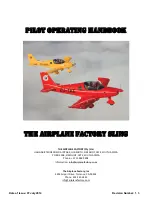
Sinus 912 LSA Glider 550 MTOW
www.pipistrel.eu
REV. 3
Appendix
9-2
Parachute rescue system: use, Handling
and servicing
System description
The GRS rocket charged parachute rescue system provides you with a chance to rescue yourself from
an unexpected situation.
The system is placed inside a durable cylinder mounted on the right hand side of the baggage com-
partment. Inside this cylinder is the parachute which stored inside a deployment bag with a rocket
engine underneath.
This brand new design deploys a canopy that is not gradually drawn from the container, exposed
to distortion by air currents, but it is safely open after 0,4 to 0,7 seconds in distance of 15-18 metres
above the aircraft. It is carried there in a special deployment bag, which decreases the risk of aircraft
debris fouling the canopy.
The parachute rescue system is activated manually, by pulling the activation handle mounted on the
back wall above. After being fired, the man canopy is open and fully inflated in about 3.2 seconds.
WARNING!
Activation handle safety pin should be inserted when the aircraft is parked or
hangared to prevent accidental deployment. However, the instant pilot boards the aircraft, safety
pin MUST be removed!
Use of parachute rescue system
Typical situations for use of the parachute rescue system are:
•
structural failure
•
mid-air collision
•
loss of control over aircraft
•
engine failure over hostile terrain
•
pilot incapacitation (incl. heart attack, stroke, temp. blindness, disorientation...)
Prior to firing the system, provided time allows:
•
shut down the engine and set master switch to OFF (key in full left position)
•
shut both fuel valves
•
fasten safety harnesses tightly
•
protect your face and body.
To deploy the parachute
jerk the activation handle hard to
a length of at
least 1 foot towards the instrument panel.
Once you have pulled the handle and the rocked is deployed, it will be about two seconds before
you feel the impact produced by two forces. The first force is produced by stretching of all the sys-
tem. The second force follows after the inflation of the canopy from opening impact and it will seem
to you that the aircraft is pulled backwards briefly. The airspeed is reduced instantly and the aircraft
now starts to descent underneath the canopy.
















































